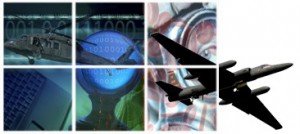Test and Evaluation (T&E) at Edwards AFB involves collecting large volumes of data that must then be processed for display, analysis, and storage in the digital world of micro-controllers, processors, and computer networks. This data processing challenge is the focus of Edwards AFB’s development of a “smart transducer” framework that supports controller-to-transducer and transducer-to-transducer processing for their T&E operations. KBSI’s Framework for Intelligent Support of Smart Transducers (FIST™) initiative built a framework that allows for a plug-and-play capability for large-scale smart transducer deployments. The FIST™ technology exploits the inherent benefits of the smart transducer technology and revolutionizes the way in which flight test and instrumentation engineers design, implement, test and manage sensor networks.
The FIST™ technology is modular, component-based, and platform-independent and can be plugged into existing Instrumentation Support Systems (ISS) using a well-defined set of APIs. In addition, the FIST™ technology supports the rapid development of customized smart sensor management applications from various components, helping developers meet the guidelines of the IEEE P1451 family of standards. The P1451 standards are pushing developers to investigate network-independent and vendor-independent transducer interfaces, the ability to quickly and easily replace and move transducers, the elimination of manual system configuration steps, and the addition of a level of smartness (i.e., self identification) into transducers. The FIST™ technology’s “smart-transducer network” methodology identifies FIST™ components and configuration details for any control application independent of the transducer vendor, the network, bandwidth, or ISS.
 In Phase I of the initiative, KBSI developed the FIST™ methodology and the component-based software that validated the methodology for T&E applications. In Phase II, KBSI focused on developing smart sensor applications for condition based maintenance and homeland security. The FIST™ technology’s modular design includes various components that can be reused for graphical interfaces, security, and intelligence support for both low-level (controller-to-transducer, transducer-to-transducer) and high-level (knowledge or action enabling information) smart transducers. This design also facilitates the direct implementation of FIST™ components into transducer cluster controllers for condition-based maintenance and for stand-alone applications (e.g., auto-pilots).
In Phase I of the initiative, KBSI developed the FIST™ methodology and the component-based software that validated the methodology for T&E applications. In Phase II, KBSI focused on developing smart sensor applications for condition based maintenance and homeland security. The FIST™ technology’s modular design includes various components that can be reused for graphical interfaces, security, and intelligence support for both low-level (controller-to-transducer, transducer-to-transducer) and high-level (knowledge or action enabling information) smart transducers. This design also facilitates the direct implementation of FIST™ components into transducer cluster controllers for condition-based maintenance and for stand-alone applications (e.g., auto-pilots).
The technology developed in the FIST™ initiative provides an unprecedented ability to rapidly and efficiently configure, maintain and operate smart transducer networks. This capability benefits Air Force and other military T&E environments and applications for condition based maintenance as well as benefiting sensor networks relating to homeland security chemical, biological, radiological, nuclear and high-yield explosives (CBRNE) defense. The FIST™ technology can also benefit any commercial instrumentation scenario requiring smart transducer capabilities, including process control and mission-critical applications in space, aeronautics, and manufacturing.
